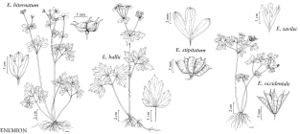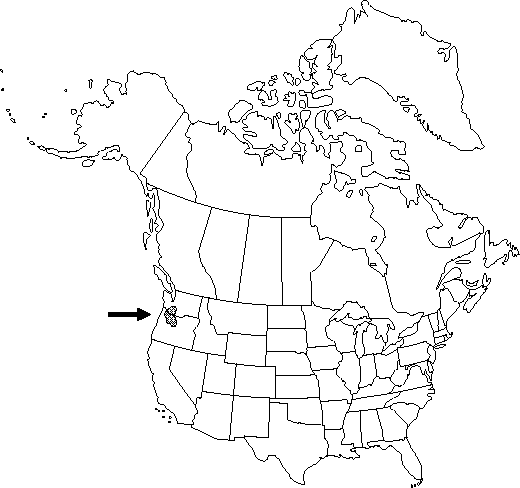Difference between revisions of "Enemion hallii"
Bull. Misc. Inform. Kew 1920: 161. 1920.
FNA>Volume Importer |
imported>Volume Importer |
||
| (7 intermediate revisions by 2 users not shown) | |||
| Line 13: | Line 13: | ||
}}{{Treatment/ID/Special_status | }}{{Treatment/ID/Special_status | ||
|code=F | |code=F | ||
| − | |label= | + | |label=Illustrated |
}} | }} | ||
| − | |basionyms={{Treatment/ID/ | + | |basionyms={{Treatment/ID/Basionym |
|name=Isopyrum hallii | |name=Isopyrum hallii | ||
|authority=A. Gray | |authority=A. Gray | ||
| + | |rank=species | ||
| + | |publication_title=Proc. Amer. Acad. Arts | ||
| + | |publication_place=8: 374. 1872 | ||
}} | }} | ||
|synonyms= | |synonyms= | ||
| Line 27: | Line 30: | ||
}}<!-- | }}<!-- | ||
| − | --><span class="statement" id="st- | + | --><span class="statement" id="st-undefined" data-properties=""><b>Stems </b>35-85 cm, with short, stout, woody rhizome; roots fibrous. <b>Leaves</b>: leaflets variously lobed and sharply dentate, apex acute, glandular-apiculate; surfaces abaxially pubescent. <b>Inflorescences</b> terminal or axillary, well-defined 3-10-flowered cymes with small scalelike bracts; peduncle not strongly clavate. <b>Flowers</b>: sepals 5-10.5 × 2.5-6.5 mm; stamens 50-75; filaments filiform to club-shaped, 4.5-8.2 mm. <b>Follicles</b> sessile, upright to widely divergent; body widely elliptic to widely obovate, 3.8-7 mm, gradually contracted into style beak; beak 1.1-2.5 mm. <b>Seeds</b> 1.8-2.2 mm, glabrous.</span><!-- |
-->{{Treatment/Body | -->{{Treatment/Body | ||
| Line 34: | Line 37: | ||
|elevation=100-1500 m | |elevation=100-1500 m | ||
|distribution=Oreg.;Wash. | |distribution=Oreg.;Wash. | ||
| − | |discussion=<p>Enemion hallii differs from all other North American members of the genus in having well-defined cymose inflorescences. Its closest ally is thought to be the east-Asian species E. raddeanum Regel, from which it differs in having long-petiolate leaves and cymose inflorescences with bracteolate subumbels. Enemion raddeanum is characterized by sessile or short-petiolate leaves and simple, umbellate inflorescences.</p> | + | |discussion=<p><i>Enemion hallii</i> differs from all other North American members of the genus in having well-defined cymose inflorescences. Its closest ally is thought to be the east-Asian species E. raddeanum Regel, from which it differs in having long-petiolate leaves and cymose inflorescences with bracteolate subumbels. <i>Enemion</i> raddeanum is characterized by sessile or short-petiolate leaves and simple, umbellate inflorescences.</p> |
|tables= | |tables= | ||
|references= | |references= | ||
| Line 43: | Line 46: | ||
-->{{#Taxon: | -->{{#Taxon: | ||
name=Enemion hallii | name=Enemion hallii | ||
| − | |||
|authority=(A. Gray) J. R. Drummond & Hutchinson | |authority=(A. Gray) J. R. Drummond & Hutchinson | ||
|rank=species | |rank=species | ||
| Line 57: | Line 59: | ||
|publication title=Bull. Misc. Inform. Kew | |publication title=Bull. Misc. Inform. Kew | ||
|publication year=1920 | |publication year=1920 | ||
| − | |special status=Endemic; | + | |special status=Endemic;Illustrated |
| − | |source xml=https:// | + | |source xml=https://bitbucket.org/aafc-mbb/fna-data-curation/src/2e0870ddd59836b60bcf96646a41e87ea5a5943a/coarse_grained_fna_xml/V3/V3_1034.xml |
|genus=Enemion | |genus=Enemion | ||
|species=Enemion hallii | |species=Enemion hallii | ||
| − | |||
| − | |||
| − | |||
| − | |||
| − | |||
| − | |||
| − | |||
| − | |||
| − | |||
| − | |||
| − | |||
| − | |||
| − | |||
| − | |||
| − | |||
| − | |||
| − | |||
| − | |||
| − | |||
| − | |||
| − | |||
| − | |||
| − | |||
| − | |||
| − | |||
| − | |||
| − | |||
| − | |||
| − | |||
| − | |||
}}<!-- | }}<!-- | ||
-->[[Category:Treatment]][[Category:Enemion]] | -->[[Category:Treatment]][[Category:Enemion]] | ||
Latest revision as of 22:45, 5 November 2020
Stems 35-85 cm, with short, stout, woody rhizome; roots fibrous. Leaves: leaflets variously lobed and sharply dentate, apex acute, glandular-apiculate; surfaces abaxially pubescent. Inflorescences terminal or axillary, well-defined 3-10-flowered cymes with small scalelike bracts; peduncle not strongly clavate. Flowers: sepals 5-10.5 × 2.5-6.5 mm; stamens 50-75; filaments filiform to club-shaped, 4.5-8.2 mm. Follicles sessile, upright to widely divergent; body widely elliptic to widely obovate, 3.8-7 mm, gradually contracted into style beak; beak 1.1-2.5 mm. Seeds 1.8-2.2 mm, glabrous.
Phenology: Flowering late spring–early summer.
Habitat: Moist woods and streambanks
Elevation: 100-1500 m
Discussion
Enemion hallii differs from all other North American members of the genus in having well-defined cymose inflorescences. Its closest ally is thought to be the east-Asian species E. raddeanum Regel, from which it differs in having long-petiolate leaves and cymose inflorescences with bracteolate subumbels. Enemion raddeanum is characterized by sessile or short-petiolate leaves and simple, umbellate inflorescences.
Selected References
None.

